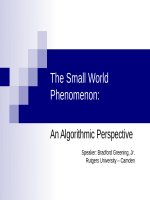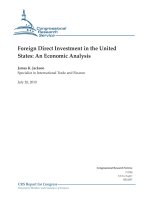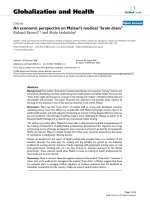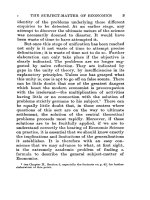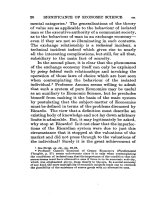The british industrial revolution an economic perspective
Bạn đang xem bản rút gọn của tài liệu. Xem và tải ngay bản đầy đủ của tài liệu tại đây (27.76 MB, 367 trang )
This page intentionally left blank
The British
Industrial Revolution
An Economic Perspective
SECOND EDITION
EDITED BY
Joel Mokyr
Westview Press
A Member of the Perseus Books Group
All rights reserved. Printed in the United States of America. No part of this publication may
be reproduced or transmitted in any form or by any means, electronic or mechanical, including photocopy, recording, or any information storage and retrieval system, without
permission in writing from the publisher.
Copyright © 1999 by Westview Press, A Member of the Perseus Books Group
Published in 1999 in the United States of America by Westview Press, 5500 Central Avenue,
Boulder, Colorado 80301-2877, and in the United Kingdom by Westview Press, 12 Hid's
Copse Road, Cumnor Hill, Oxford OX2 9JJ
Library of Congress Cataloging-in-Publication Data
The British industrial revolution: an economic perspective / edited
by Joel Mokyr.
p, cm.
"Second edition"—P.
A collection of 4 new or updated essays and the editor's
introduction, a survey and evaluation of contemporary research.
ISBN 0-8133-3389-X (pbk.)
1. Industrial revolution—Great Britain. 2. Great BritainEconomic conditions—1760-1860. 1. Mokyr, Joel
HC254.5.B88 1998
338.0941—dc21
98-45108
CIP
The paper used in this publication meets the requirements of the American National Standard for Permanence of Paper for Printed Library Materials Z39.48-1984,
10
9
8
7
6
5
4
3
2
1
Dedicated to
tnc mcniory oi
JONATHAN R.T. HUGHES
This page intentionally left blank
Contents
List of Tables and Figures
Acknowledgements
1.
2.
3.
4.
5.
Editor's Introduction; Tie New Economic History
and tie Industrial Revolution
JoelMokyr
Tie Fable of tie Dead Horse; or, Tie Industrial
Revolution Revisited
David S, Landes
ix
xi
1
128
Reassessing tie Industrial Revolution:
A Macro View
C, KnickHorley
160
Too Muci Revolution: Agriculture in tie
Industrial Revolution, 1700-186©
Gregory Clark
206
Tie Role of Education and Skill in tie Britisi
Industrial Revolution
David Mitch
241
Bibliography
About the Book
About the Contributors
Index
230
331
332
This page intentionally left blank
Tables and Figures
Tables
1.1
1.2
1.3
1.4
1.5
Estimated Annual Rates of Growth, 1700-1871
Exports Growth, 1700-1S51
Coun.erfac.ual Decline in Income per Capita "Without"
an Industrial Revolution
Nominal Wages, Real Wages, and Prices, 1787-1851
Nominal Wages, Prices, and Real Wages, 1787-1872
115
118
120
2.1
2.2
2.3
Great Britain: Growth Rates in Real Output, 1700-1860
Index Numbers of British Real Output, 1760-1800
Relative Backwardness of Groups of Countries, 1800-1970
134
135
155
3.1
3.2
3.3
3.4
3.5
3.6
Indices of Output, Various Industties
Industrial Structure, 1841,1815, and 1770
Indices of Aggrepte Industrial Production, 1700-1841
National Income, 1700-1870
Sources of Growth, 1700-1860, Crafts' Estimates
Sectoral Contributions to Productivity: Annual Percentage
Growth, 1780-1860
Cotton Textile Production and Consumption, Effects of
Terms of Trade
168
171
172
178
183
3.7
4.1
4.2
4.3
4.4
4.5
4.6
11
69
184
187
4.7
Estimated Productivity Levels, 1700-1860
Agricultural Performance Ckca 1850
Threshing Rates by Half Century, 1600-1850
Numbers of Recorded Wage Payments by Month, 1690-1730
Nominal and Real Ap'iculniral Output, 1700-1861
Production and Imports of Food, Raw Materials and Energy,
1700-1850
Estimated Output Levels, 1700-1860
207
211
227
228
232
234
237
5.1
5.2
Male Illiteracy by Occupational Group for English Parishes
Skilled Wage Premiums
263
269
Figures
2.1
2.2
2.3
3.1
3.2
3.3
3.4
4.1
4.2
4.3
4.4
4.5
4.6
4.7
4.8
Great Britain. And End to Maltbusian Penalties, 1781 on
Great Britain. Trend Growth of Industeial Output, 1700-1900
Great Britain. The Learning Curve in Textile Manufacture—
Selling Price- of Cotton Yam and the Cost of Raw Cotton,
1779-1882
137
149
151
Population and Real Wage, England and Wales, 1250-1980
Estimates of Industrial Production
British National Income, 1700-1870
Military Expenditures and National Income 1690-1830,
constant prices
161
173
180
203
Predicted Agricultural Outejut in Britain, 1700-1850
The Pre-Industrial Nitrogen Cycle
Rent of Meadows in Terms of Hay and Animal Products
The Rent of Arable in Bushels of Wheat
The Predicted ReturnfromEnclosing Land, 1600-1839
Predicted Ricardian Surplus Per Acre Versus Rent Per Acre
Real Rents, Wages, and Return on Capital
Productivity Growth in English Agriculture
208
213
214
216
221
225
230
231
Acknowledgments
It is a pleasant duty to acknowledge the many individuals who have helped
make this book possible. Thefirstedition was made possible through the
indispensable support of Spencer Can. Joyce Bumette's competent and dedicated
assistance in preparing and typesetting the first edition was matched by Tom
Geraghty's ingenuity and diligence in the second. The entire book was typeset on
Corel's WordPerfect 7.0, which worked to perfection, the efforts of Bill Gates
and his software writers notwithstanding.
This page intentionally left blank
1
JL/Uii'v)! 2> XXJLlXv/U-Uv'Uv/Xl*
The New Economic History
and the Industrial Revolution
Joel Mokyr
T i e Industrial Revolution — a Useful Abstraction
In the past years, there have been more and more voices that claim, to rephrase
Coleman (1983), that the Industrial Revolution is "a concept too many."1 The
feeling is that the term is either too vague to be of any use at all or that it produces
false connotations of abrupt change comparable in its suddenness to the French
Revolution. The main intellectual motive for this revision has been the growing
(though not universally shared) consensus that economic growth in the early stages
of the British Industrial Revolution was slower than had hitherto been supposed.
The idea of the Industrial Revolution, however, predates its identification with
economic growth by many decades. The revision of national income statistics
should therefore not, in itself, be enough to abandon the concept. Yet revisionist
social historians have found in those revisions the support to stole categorically mat
"English society before 1832 did not experience an industrial revolution let alone
an Industrial Revolution.... [Its] causes have been so difficult to agree on because
there was no 'Industrial Revolution,* historians have been chasing a shadow"
(Jonathan Clark, 1986, pp. 39, 66). Wallerstein (1989, p. 30) suggests amazingly
that "technological revolutions occurred in the period 1550-1750, and after 1850,
but precisely not in the period 1750-1850." Cameron (1990, p. 563) phrases it even
more vituperatively: "Was there an industrial revolution? The absurdity of the
This essay is a completely revised and largely rewritten version of my introduction
to an earlier collection (Mokyr, 1985a). I am indebted to Gregory Clark, Stanley Engerman,
C. Kniek Harley, David Landes and Rick Szostak.forcomments on an earlier version. The
second edition was much improved thankstoTom Geraghty and Peter Meyer.
'Among those, see especially EX. Jones (1988, pp. 13-27); Clive Lee (1986, pp.
21-22).
2
Joel Mokyr
question is not that it is taken seriously but that the term is taken seriously... by
scholars who should know better."
The important point to keep in mind is, of course, that from a purely ontological
point of view, the British Industrial Revolution did not "happen." What took place
was a series of events, in a certain span of time, in known localities, which
subsequent historians found convenient to bless with a name. The argument
whether the Industeial Revolution is a useful concept is therefore merely one about
the efficiency of discourse: Does the term communicate? Do most people with
whom we want to converse (colleagues, students, book purchasers) know by
approximation what we mean when we use the term? And can we suggest a better
tenn to replace it in our conversations? T. S. Ashton wrote in 1948 that the term
was so widely used that it would be pedantic to offer a substitute (1948, p. 4; see
also Crate, 1985a, p. 68). Nothing has been learned since then to warrant changing
that conclusion. Continuity or discontinuity, as McCloskey (1987) notes, are
rhetorical devices. There is no "test" that we can apply: National income and
aggregate consumption pew gradually; patents and cotton output grew much faster.
Which one "measures" the Industrial Revolution?
Given this background, the sometimes strident voices calling for the banning of
the word from our textbooks and journals seem off the mark and, to judge from the
writings of scholars in the 1990s, have had little influence. Economic historians,
like all scholars, need certain terms and concepts with which they can conduct their
discourse, even if arguments about the precise definitions of these concepts
continue. But scholars feel that the term communicates and insist on using it In the
years since the first edition of this book appeared, a number of important books and
articles whose titles include the term Industrial Revolution have appeared, which
demonstrates that their authors believe that the Industrial Revolution means
something to their readers.2
To be sure, arguments about what exactly changed, when it started, when it
ended, and where to place the emphasis keep raging. Such scholarly debate about
the exact content of a central concept is common - think of the arguments among
biologists about the concept of species. Yet this is insufficient cause to abandon the
term altogether: One might as well abandon such concepts as the Reformation or
Imperialism.
How revolutionary was the Industrial Revolution? Compared to political
revolutions, like the American and French revolutions that were contemporaneous
with it, it was rather drawn-out, its dates usually set between 1760 and 1830
following Ashton (1948). To be sure, it was punctuated by some periods of feverish
2
For instance Allen (1994); Crafts (1994; 1995a, 1995b, 1995c); Crafts and Mills
(1994); Easterlin (1995); Engerman (1994b); Hawke (1993); Horrell (1995a); Fisher (1992);
Huck (1995); Jackson (1994); Solar (1995); Goldstone (1996); Meignen (1996); Meal
(1994); Nicholas and Oxley (1993,1994); Snooks (1994); Teich and Porter (1996); Temin
(1997).
Editor's Introduction
3
activity such as the year 1769, the annus mirabilis as Donald Cardwell (1972)
called it, in which both James Watfs separate condenser and Richard Arkwright's
water frame were patented. But, on the whole, economic changes, even economic
revolutions, do not have their Bastille Days or their Lenins. Economic change is
rarely dramatic, sudden, or heroic. Consequently, some scholars have found the
revolutionary aspects difficult to stomach. John Clapham and Herbert Heaton, the
doyens of economic history in the 1930s and 1940s, shunned the term Industrial
Revolution altogether. In contrast, historians in the 1960s wrote of "Great
Discontinuities" (Hartwell, 1971b) and "take-offs" (Rostow, 1960). Yet gradualism
remained strong. Hughes (1970, p. 45) said it well when he wrote that anything that
lasts so long is hard to think of as abrupt and added that "we cannot think of the
events of the past seventy years as sudden. Seventy British years [to the period
1760-1830] passed no more rapidly."
There is merit to this argument, but not enough to abandon the terminology.
Revolutions do suppose an acceleration of the rate of change, but how much does
the rate have to change in order for it to qpalify? Seventy years is a long period, but
the changes that occurred in Britain between 1760 and 1830 dwarfed in virtually
every respect the changes that had occurred in the previous seventy years.3 The
annual rate of change of practically any economic variable one chooses is far higher
between 1760 and 1830 than in any period since the Black Death. The key concept
is an increase in the rate of change, not the occurence of change itself. The cartoon
story of a preindustrial static society before 1750 with fixed technology, no capital
accumulation, little or no labor mobility, and a population hemmed in by
Malthusian boundaries is no longer taken seriously. Jones (1988) has stressed this
point more than anyone else. At the same time Jones points out that before 1750
periods of growth were followed by retrenchment and stagnation. The Industrial
Revolution was "revolutionary" because the technological progress it witnessed and
the subsequent transformation of the economy were not ephemeral events and
moved society to a permanent different economic trajectory. Moreover, it seems too
much to demand that an event qualify as a revolution only if it follows a period of
total stasis — most political revolutions cannot meet this standard either.
Furthermore, revolutions are measured by the profundity and longevity of their
effects. In this regard, what happened in Britain after 1760 qualified beyond serious
doubt for revolutionary status. The effects of the Industrial Revolution were so
profound that, as Paul Mantoux (1928, p. 25) notes, few political revolutions had
such far-reaching consequences.
One of the more perplexing phenomena is that contemporaries seemingly were
unaware of the Industrial Revolution. A number of scholars have commented on the
notable absence of references to anything as dramatic in the writing of political
3
As Ashton (1948, p. 41) writes, "In the period 1700-1760 Britain experienced no
revolution, either in the techniques of production, the structure of industry, or the economic
and social life of the people."
4
Joel Motyr
economists and novelists writing in the years before 1830 (Cameron, 1994; cf.
North, 1981, p. 160, Adams, 1996, p. 106, and McCloskey, 1994, p. 243). From this
it is inferred, somewhat rashly, that contemporaries were unaware that they were
living during an Industrial Revolution and from this it is further inferred, even more
rashly, that hence the term is useless. The latter inference is absurd: how many
people in the Roman Empire referred to themselves as living during "classical
antiquity?"4 Yet the premise that contemporaries were unaware of the Industrial
Revolution is simply and patently false. To be sure, they did not pay to it nearly the
attention that subsequent historians have, but why should they have, not knowing
where all this was leading? By confining oneself to reading Adam Smith (who
published his Wealth of Nations in the very early stages of the Industrial
Revolution), T.R. Malthus (who was above all interested in population and
agriculture), or Jane Austen (who lived mostly in the South of England), one can
easily misrepresent the perceptions of contemporaries. The Scottish merchant and
statistician Palrick Colquhoun (1814, pp. 68-69) in a famous quote declared that "It
is impossible to contemplate the progress of manufactures in Great Britain within
the last thirty years wilhout wonder and astonishment. Its rapidity ... exceeds all
credibility. The improvement of the steam engines, but above all the facilities
afforded to the great branches of the woolen and cotton manufactories by ingenious
machinery, invigorated by capital and skill, are beyond all calculation..." At about
the same time, Robert Owen (1815, pp. 120,121) added that "The general diffusion
of manufactures throughout a country generates a new character in its inhabitants...
This change has been owing chiefly to the mechanical inventions which introduced
the cotton trade into this country... the immediate effects of this manufacturing
phenomenon were a rapid increase in the wealth, industry, population, and political
influence of the British Empire." David Ricardo, despite being mainly interested in
theoretical questions inserted a chapter on Machinery into the third edition of his
Principles of Political Economy in which he is concerned with its impact on
employment, an issue known as "the Machinery Question" and which only makes
sense in the context of the Indusnial Revolution (Berg, 1980).5 Other writers and
Clearly awareness by contemporaries of the nature of the period in which they
lived is riot an, absolute rule in Professor Cameron's book. He uses the term "Middle Ages"
without qualm (chapter 3 of his textbook is called "Economic Development in Medieval
Europe"). He mayfindit interesting to learn that the term wasfirstused by one Christopher
Keller or Cellarius in a book that appeared first in 1688, Although there, too, have been
"countless reflections on the appropriateness of its label" the terra has survived in conventional usage. See Fuhrmann, (1986), p, 16. I am indebted to my colleague Robert E.
Lemer for bringing this reference to my attention.'
5
E.A. Wrigley (1994, pp. 30-31) makes essentially the same point when he notes
that classical economists and their contemporaries were perfectly aware of the technological
developments of their age and that it is impossible to doubt that Smith, Ricardo, and Malthus
were as knowledgeable as anyone on these matters. Most political economists, however,
Editor's Introduction
5
essayists, each from Ms or her own perspective, made similar comments. Similarly,
literary references to the Industrial Revolution are not altogether absent, and
Wordsworth, Blake, Charlotte Bronte, and Elizabeth Gaskell contain unambiguous
references to the Industrial Revolution (see Mokyr, 1994, pp. 194-95 for details).
Such references are relatively rare, but given the locational concentration of the
Industrial Revolution in its earlier stages, this is not surprising.6
Nevertheless, there is a kernel of truth to hie notion that the Industrial Revolution
looms larger to us than it did to contemporaries. History is inevitably written with
a certain amount of "presentism" Hindsight provides us with a tool to assess which
details matter and which do not. In some instances, of course, this tendency should
not be exaggerated. Some dead-ends and failures "mattered" as much as success
stories and can be instructive for many reasons. The knowledge, however, that the
Industrial Revolution set into motion a historical process of momentous global
consequences is available to us and was not to contemporaries, it is a matter of taste
and judgment to what extent that Mnd of knowledge should influence our work. Yet
the thousands of scholars concerned with some aspect of economic growth, technological change, industrialization, and the emergence of the modem economies
after 1750 are all employing this kind of judgment and for good reason. In 1815 it
was impossible to discern whether the "wonderful progress of manufactures" was
a temporary affair or the beginning of a sustained cumulative process of social and
technological change, and some political economists believed, largely on a priori
grounds, that progress would be temporary. Yet it is ludicrous for an economic
historian at the end of the twentieth century to pretend to be equally ignorant.
In sum, in considering whether there "was an Industrial Revolution" I cannot do
better than cite Max Hartwell, summarizing a career of study and reflection on the
topic "Was there an Industtial Revolution?" succinctly: "There was an Industrial
Revolution and it was British" (Hartwell, 1990, p. 575). Despite the announcements
of opponents of the concept that modem research has demonstrated its vacuity,
much recent work that looks beyond the aggregate statistics into the regional and
microeconomic aspects of the Industrial Revolution emphasizes the acceleration
rejected sustained economic growth as an equilibrium condition, largely on a priori grounds.
As the area and the number of people affected by the Industrial Revolution
increased,fiction,too,startedtotake note. In 1832 Elizabeth Gaskell moved to Manchester
where she studied the same conditions that Friedrich Engels witnessed a decade later,
resulting in her Mary Barton (1848). Both saw the same thing. Gaskell did not call it an
Industrial Revolution (Engels did) but what they saw clearly disturbed them. Factory
conditions are described in novels of the 1840s, obscure ones such as Frances Trollope's
Michael Armstrong, the Factory Boy (1840) and Charlotte Elizabeth (Tonna)'s Helen
Fleetwood (1840) and well-known ones such as Dickens's The Old Curiosity Shop (1841)
and Disraeli's Sybil (1846). It is inconceivable that these authors were observing conditions
that were brand-new.
6
Joel Mokyr
and irreversibility of economic change in the regions associated with the
Revolution.7
The origin of the term Industrial Revolution was long attributed to two Frenchspeaking observers writing in the 1830s, the Frenchman Jerome-Adolphe Blanqui
and the Belgian Natalis de Briavoinne.8 As David Landes shows elsewhere in this
book, its origins can be traced back even further. All the same, there is little dispute
that the term became popular following the publication of Arnold Toynbee's famous
Lectures on the Industrial Revolution"m1884. The term is taken to mean a set of
changes that occurred in Britain between about 1760 and 1830 that irreversibly
altered Britain's economy and society. Of the many attempts to sum up what the
Industrial Revolution really meant, the most eloquent remains Harold Perkin's; MA
revolution in men's access to the means of life, in control of their ecological
environment, in their capacity to escape from the tyranny and niggardliness of
nature . . . it opened the road for men to complete mastery of their physical
environment, without the inescapable need to exploit each otfaef* (Perkin, 1969, pp.
3-5).
Although economic historians tend naturally to emphasize its economic aspects,
the Industtial Revolution illustrates the limitations of the comparttnentalization of
historical sciences. More changed in Britain in those years than just the way goods
and services were produced. The role of the family and the household, the nature
of work, the status of women and children, the social role of the church, the ways
in which people chose their rulers and supported their poor, what people wanted to
know and what they knew about the world—all these were altered more radically
and faster than ever before. It is an ongoing project to disentangle how economic,
technological, and social elements affected each other. The event itself transcended
any definable part of British society or economic life; it was, in Per/kin's phrase, a
"more than Industrial Revolution."
What, then, was it that changed in the years that we refer to as the Industrial
Revolution? We shall have to leave out of the discussion many of the aspects that
made it a "more man Industrial Revolution"—attitudes, class consciousness, family
For example, Marie Rowlands (1989, p. 124), who tries hard to fnd continuity
in the economic changes in the West Midlands, is still describing it in dramaticterms:"There
can be no question of the revolutionary impact of the introduction of the coal-fired blast
furnace into the areafrom1766. Within a single generation the furnaces... revolutionised
not only the south Staffordshire economy but also its settlement pattern and landscape....
Agriculture became progressively more difficult, the night sky was illumined withflamesand
the day darkened with smoke, and the district began to be called the Black Country."
Similarly, John Walton, writing of Lancashire, has no doubt that "there is something
cumulatively impressive to explain. Nothing like it had been seen before.... The chain of
events began in the 1770s and gathered . . . overwhelming momentum in the nineteenth
century" (Walton, 1989, p. 64).
8
BIanqui (1837, p. 389); Briavoinne (1839, vol. 1, pp. 185ff.).
Editor's Introduction
7
life, demographic behavior, political power, though all of these were transformed
during the same period—and concentrate on economic variables. Four different
schools of thought about "what really mattered" during the Industrial Revolution
can be distinguished,* The four schools differ in matters of emphasis and weight,
yet they overlap to such an extent that many writers cannot be readily classified.
1. The Social Change School. The Industrial Revolution is regarded by the
Social Change School to have been first and foremost a change in the way
economic transactions between people took place. The emergence of formal,
competitive, and impersonal markets in goods and factors of production is the basis
of this view.. Toynbee ([1884] 1969, p. 58) writes that "the essence of the Industrial
Revolution is the substitution of competition for the medieval regulations which had
previously controlled the production and disteibution of wealth." Karl Polanyi
([1944] 1985, p. 40) judges the emergence of the market economy as the truly
fundamental event, to which everything else was incidental. A more recent
contribution in this spirit, which emphasizes the emergence of competitive markets
in manufacturing is Wijnberg (1992). Most modem social historians probably
would view the central social changes as having to do with labor and the relation
of workers with their work environment, other laborers, employers, and capitalists.
An enormously influential work in this regard is E. P. Thompson (1963). Some
recent contributions influenced by this work are Berg and Hudson (1992) and
Randall (1991).
2. The Industrial Organization School. Here the emphasis is on the structure
and scale of the firm - in other words, on the rise of capitalist employment and
eventually me factory system. The focal point is the emergence of large firms, such
as industrial mills, mines, railroads, and even large retell stores, in which
production was managed and supervised and where workers were usually
concentrated under one roof, subject to discipline and quality control. The work of
Mantoux (1928) is a classic example oftffaisschool, but Karl Marx's interpretation
of the rise of "Machinofactures" also belongs here as do some modern writers in
the radical tradition (Margin, 1974-1975). A classic work discussing the Industrial
Revolution from this point of view is Pollard (1965), In the same tradition is Berg
(1994). More recently, Szostak (1991) has argued that changes in the organization
of the firm were the causal factor in technological change and thus primary to it
Goldstone (1996) explicitly equates the Industrial Revolution to the emergence of
the factory system and argues that because China was unable for social reasons to
adopt factories, the Industrial Revolution came late to it.
A somewhat different microeconomic approach to the Industrial Revolution
emphasizes the distinction between circulating capital and fixed capital, a
distinction that goes back to the classical political economy of David Ricardo and
Marx. Some modem economists have defined the Industrial Revolution as a shift
9
What follows is inspired by Hartwell (1971b, pp. 143-154), although the
classification here differs to some extent
8
Joel Mokyr
from an economy in which capital was primarily of the circulating kind (e.g., seed
hi apiculture and raw materials in domestic industry) to one in which the main form
which capital took was fked capital (e.g. machines, mines, and steuctares) (Hicks,
1969, pp. 142-43; Ranis and Fei, 1969).
3. The Macroeconomic School. The Macroeconomic School is heavily
influenced by the writings of Walther Hoffmann and Simon Kuznets. Here the
emphasis is on agpegate variables, such as the growth of national income, the rate
of capital formation or the aggregate investment ratio, or the growth and
composition of the labor force. Rostow (1960) and Deane and Cole (1969) are
important proponents of this school, and their influence has extended to
noneconomists (e.g., PerMn, 1969, pp. 1-2). Recent statements by E. A. Wrigley
and Gary Hawke that baldly define the Industrial Revolution in terms of economic
growth (Wrigley, 1987, p. 3; Hawke, 1993, p. 58) show that this approach still
enjoys some support despite growing evidence that economic growth during the
Industrial Revolution was unremarkable. Some writers, such as Gerschenkron
(1962), prefer to ag^egate on a sectoral level, dealing with the rate of growth of the
manufactoring sector rather than the growth of the entire economy. Early
practitioners of the New Economic History have tended to belong to this school,
because by its very nature it tends to ask questions about large collections of
individuals rather than about single persons (Fogel, 1983, p. 29) and because of its
natural interest in quantitative analysis.
4. The Technotopcal School. The Technological School considers changes in
technology to be primary to all other changes and thus focuses on invention and the
diffusion of new technical knowledge. Technology is more than just "gadgets," of
course; It encompasses techniques used for the organization of labor, consumer
manipulation, marketing and disttibution techniques, and so forth. The most
influential book in this school is Landes (1969).
The attitudes of many writers regarding the revolutionary nature of the period is
to some extent determined by the school to which they adhere. The most confirmed
advocates of discontinuity have typically been technological historians. Quantitative
analysis of patent statistics reveals a sharp Mnk upward in the late 1750s (Sullivan,
1989). Insofar as the level of technical innovation can be approximated by
patenting, this finding lends support to the discontinuity hypothesis. Nonquantitative economic historians with a strong interest in technology have had little
difficulty with the discontinuity implied by the use of the concept of the Industrial
Revolution. David Landes's chapter in this book represents a summary of this view,
which goes back at least to the writings of A. P. Usher and before.10 Another
Usher (1920, p. 247), in a chapter entitled "The Industrial Revolution," cites with
approval J. A. Blanqui for stressing the profound changes occurring in his own lifetime (the
1830s) and adds that the two revolutions, the industrial in England and the political in
France, each in their own way contributed to a break with the past "so complete that it is
difficult for us to reconstruct the social life of the old regime."
Editor's Introduction
9
leading technological historian, D.S.L. Cardwell (1972, p. 139), uses the term
revolutionary epoch (which he reserves for the years 1790-1825), whereas Arnold
Pacey (1975, p. 216) prefers to apply the term revolutionary to the last third of the
eighteenth century. In a more recent work, however, he has no qualms about using
the term Industrial Revolution (Pacey, 1990, chap. 7). H. I. Button (1984), Richard
Hills (1979, p. 126), and Bertrand Gille (1978, p. 677) stress the technological
discontinuities of this period. Maurice Daumas, despite reservations, accepts the
concept for the case of Great Britain between 1775 and 1825 (1979, p. 8). Akos
Paulkyi expresses the sentiments of many when he writes that "the perception [mat
denies the revolutionary character of the innovations during the Industrial
Revolution] bewildered me because in no book on the history or philosophy of
technology is it doubted mat the technological changes which took place between
1760 and 1860 introduced a new era" (1986, p. 261). In his recent book on science
and technology, Ian Inkster supports this view and adds that "removing the
Industrial Revolution may simply lead to boredom" (1991, p. 61). Without
necessarily accepting this view, it seems fair to object to a de-dramatization of the
events purely because of some preconception that "nature does not make leaps."
On the other hand, historians interested in macroeconomics and emphasizing
economic growth have in recent years found Ettle support for discontinuities. In this
they differ from earlier aggregative approaches such as Rostow (1960) and Deane
and Cole (1969), which seemed to find sudden leaps in the macroeconomy. As
Harley's essay in this book makes clear in more detail, modern research has
established that economic growth before 1830 was slower than was previously
thought. This could lead to the conclusion that the acceleration, if there was one at
all, does not merit the adjective revolutionary. Table 1.1 presents average annual
compound rates of growth of the economy before and during the Industrial
Revolution, contrasting earlier and more recent efforts.
Compared to Deane and Cole's national income statistics, Crafts' figures reveal
an aggregate growth that was much slower during the Industrial Revolution.
Industrial production is more ambiguous; Hoffmann's data, computed in the 1930s,
clearly show a rapid acceleration during the period of the Industrial Revolution, but
Deane and Cole's series is much more erratic and, like the revisionist data of Harley
and Crafts, show that most of the quantitative expansion occurred after 1800. All
the same, Crafts and Harley explicitly deny adhering to a school that would negate
the profound changes that occurred in Britain during the Industrial Revolution
(1992) and restate that "industrial innovations... did create a genuine Industrial
Revolution reflected in changes in Britain's economic and social structure," even
if their impact on economic growth was more modest than previously believed (p.
3). The point stressed by Crafts and Harley, as well as by students of other episodes
of rapid technological change, is worth repeating: There is typically a long lag
between the occurrence of changes in technology, even those of fundamental
importance, and the time they start affecting agjp*egate statistics such as industrial
production and national income per capita.
JoelMokyr
10
The revisionist view of the Industrial Revolution proposed by Harley and Crafts
has led to lively exchanges with scholars critical of their methodology and views.
Landes (below) still feels that during the Industrial Revolution growth of per capita
income accelerated to the extent that we are justified in considering the Industrial
Revolution a breaking point. In a different mode, a number of scholars have
attacked the quantitative methodology underlying the revisionism and pointed out
mat rather than based on new research, the new series proposed were a reshuffling
of the same raw materials used by Deane and Cole and questioned one detail or
another in the technical procedures (Hoppitt, 1990; Jackson, 1992,1994; Cuenca,
1995). In particular, as table 1.1 indicates, Javier Cuenca has questioned the
estimates of industrial output growth produced by Crafts and Harley. Given the
significant role of me lower industrial output p-owth estimates in GDP (Jackson,
1994, p. 91) these scholars can be seen to have taken issue with the fundamental
revisionism which contends that during the Industrial Revolution agj^egate growth
rates were far lower than Deane and Cole had originally postulated.11 All the same
it remains a matter of consensus that we do not observe, and indeed should not
observe a sharp break in aggregate long-term growth rates.
On a different front, the Crafts-Harley has been criticized by Berg (1994) and
Temin (1997). Part of the economic logic of the Crafts-Barley view of slow growth
was that productivity |p*owth and technological progress were confined to a few
relatively small sectors such as cotton, wool, iron, and machinery whereas much of
the rest of manufacturing remained more or less stagnant till after 1830. Temin
maintains that this argument is inconsistent with the patterns of British foreign
11
'The most effective criticism was made by Cuenca (1994) who has questioned the
procedures used by Crate and Harley (1992) to estimate the growth of the cotton industry
during the Industrial Revolution. Cotton output was the fastest growing component of
industrial production, and its relative share in industrial output is thus a crucial variable in
the estimation of industrial output. Cuenca argues that cotton prices fell rapidly after 1770
and hence output was growing faster than is generally believed. His revisions in the prices
of cotton raise the rate of output growth of industrial productionfromthe 1.27 percent per
year estimated by Crafts and Harleytoa much higher level of 2.61 percent, higher even than
Deane and Cole's estimate. In their "reply", Crafts and Harley (1995) dispute the price series
used by Cuenca and point out that hisfiguresimply that in 1770 the relative share of cotton
in the industrial sector was far larger than was hitherto assumed which explains the large
increase in aggregate industrial output claimed by Cuenca, In any case, even the radical
revisions in industrial growth proposed by Cuenca do not change GDP growth rates by all
that much,fromthe 1 percent per year (1760-1801) estimated by Crafts to about 1.4 percent
(ibid,, p, 142). Still, such seemingly small differences in growth rates compounded over 40
years would mean that GDP would be 75 percent higher in 1801 than in 1760, as opposed
to 49 percent by the lower growth rates. Since population grew at around 0.8 percent per
annum over the same period, meaning that population in 1801 was about 40 percent higher
than in 1760, these differences imply rather dramatic differences in income per capita growth.
Editor's Introduction
11
TABLE 1.1 Estimated Annual Rates of Growth, 1700-1.871. (in percentages)
National
Income
per cap.
(Deane
&
Cole)
National
Income
per cap.
(Crafts)
Indust.
Indust.
Product
Product
(Hoff(Deane
mann)dCole)
17001760
0.44
0.3
0.67
0.74
17601800
0.52
0.17
2.45
1.24
18001830
1.61
0,52
2.70
4.4
J 8301870
1.98
1.98
3.1
2.9
Period
Indust.
Indust.
Product
Product
(Harley)(Crafts)
Indust.
Product
(Cuenca)
0.62
—
1.6*
1.96
2.61'
3,2b
3.0
3.18
a-1770-1815
b-1815-1841
c-1770-1801
Source: ComputedfromHarley (below); Hoffmann (1965); Cuenca (1994).
trade, which clearly shows that Britain maintained a comparative advanlage not just
in the rapidly expanding "new industries" but in a host of small, older industries
such as linen, glass, brewing, pottery, buttons, soap, candles, paper, and so on.
Temin relies on export figures to make a point about comparative advantage and to
infer from it indirectly that technological progress occurred on a variety of fronts.
Anecdotal evidence and examples of progress in industries other than the
paradigmatic Mgh-flying industries can be culled together from specialized
sources.12
Nonquantitative analysts also disagree on the issue. The Social Change School
tends to be divided: Toynbee and his contemporary H. Gibbins (1895) thought that
the changes that mattered most were rapid. Modern social historians such as
Jonathan Clark would clearly disagree. More recent work (e.g., Berg and Hudson,
1992) asserts that the pendulum has swung too far in the direction of gradualism
and points to a number of radical and discontinuous social changes. The same holds
for the Industrial Organization School; whereas Mantoux clearly believed in sudden
12,
On the hardware industry, see Berg (1994), ch. 12. On many of the other
industries classic industry studies carried out decades ago have not yet been supplanted such
as Coleman (1958) on the paper industry, Mathias [1953,(1979)] on brewing, Haber (1958)
on the chemical industries, Church (1970) on the shoe and boot industry, McKendrick (1961,
and 1982b) on potteries, and Barker (1960) on glass.
Joel Mokyr
and rapid change, modern scholars in this tradition are more gradualist in their
views and stress the dynamic elements in the pre-1760 economy, Maxine Berg
(1994) has resisted the new quantitative orthodoxy of Harley and Crafts while
insisting at the same time (p. 281) that "industrial growth took place over the whole
eighteenth century and not just in the last quarter of it." In any event, there is no
justification for extreme statements such as that of Musson (1978, p. 149), who
flatly declares that by 1850 Britain was not a very different economy than it had
been in 1750. After all, the population of Britain had tripled by that period, and at
least in some regions everyming, from the landscape to the occupational structure,
had been turned upside down. The statement is, perhaps, closer to the truth for
southern and eastern England and the Scottish Highlands, but even there it is
debatable.
Debates on gradualism vs. sudden change are not specific to the literature on the
Industrial Revolution or even economic history. There has always been an
intellectual current that believed with Charles Darwin and Alfred Marshall that
Nature makes no leaps. Within evolutionary biology, a debate between gradualists
and saltationists has been conducted with equal intensity and perhaps similarly
inconclusive results (Mokyr, 1990b, 1991a). After many years of undisputed reign
by gradualists, a new compromise is emerging that allows for sudden outbursts of
accelerated change although not insisting that all historical change is necessarily of
that kind. It seems that economic historians and evolutionary biologists have been
walking on parallel paths.
A moment of reflection and a few simple computations indicate that for a country
that undergoes structural change while it grows, very sudden accelerations in the
growth rate of the kind that Rostow envisaged are simply impossible. Thus the
finding mat the aggregate effects of the Industeial Revolution are not oveiwhelming
before 1820 is not surprising. It is useful for this purpose to regard Britain during
the period of the Industeial Revolution as a dual economy in which two economies
coexisted although the argument would be no different if we considered a
continuum of many sectors. One was the traditional economy, which, although not
stagnant, developed gradually along conventional lines, with slow productivity and
slowly rising capital-labor ratios. This sector contained ajpeulture, construction,
domestic industry, and many traditional "trades" that we would now classify as
industrial but which in the eighteenth century and before were partially commercial:
bakers, millers, tailors, shoemakers, hatters, blacksmiths, tanners, and other
craftsmen. The modern sector consisted of cotton, iron smelting and refining,
engineering, heavy chemicals, mining, some parts of transportation, and some
consumer goods such as pottery and paper. At first, however, only segments of
these industries underwent modernization, so that dualism existed within as well as
between various products, which makes calculations about the performance of the
